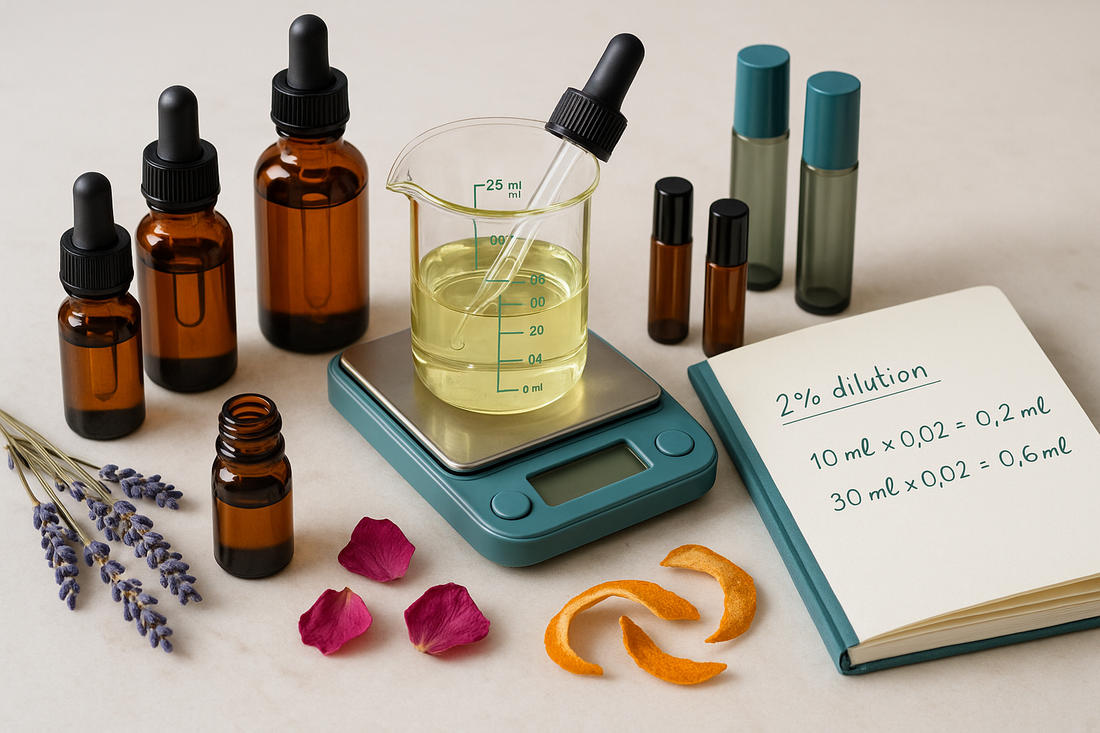
Blending with Essential Oils
Blending essential oils for therapeutic application
Blending essential oils lies at the heart of aromatherapy, uniting creativity with science to achieve balanced and effective results. The process goes beyond simply mixing pleasant scents, it involves understanding how different oils work together, both aromatically and chemically, to create synergy and maximize therapeutic benefits. By exploring vertical and horizontal blending, mastering the use of fragrance notes, and considering the chemical composition of each oil, aromatherapists can design blends that are not only enjoyable but also tailored to individual wellness needs and safety.
The art of blending
Vertical Blending
Aromatherapists are taught to use vertical or horizontal blends. For a holistic blend—that is, a treatment for the whole body and mind—a vertical blend is used. For example, orange (a top note) boosts mood, lavender (a middle note) eases joint and muscle discomfort, and cedarwood (a base note) calms the mind and helps “fix” the fragrance, ensuring longevity. This approach combines different note categories to create a rounded, enduring scent with broad therapeutic benefits.
Horizontal Blending
A horizontal blend typically addresses one condition—such as a cold—by combining oils like eucalyptus (to ease breathing), tea tree (to help protect against infection), and lavender (to aid sleep). All these oils are middle notes, which is why it’s called a horizontal blend. Any blend of essential oils for treatment is referred to as a synergy, because the individual oils work together to resolve the health and well-being problem.
What is the “Note” Classification of Essential Oils?
When aromatherapists refer to top, middle, and base notes, they are describing the “fragrance hierarchy.” Each note shapes the overall experience, harmony, and effect of a blend:
- Top notes: The first scents noticed (often citrus oils), which are light, uplifting, and dissipate quickly.
- Middle notes: Fuller, richer scents (often from leaves, grasses, or flowers) that provide balance, calm, or uplift.
- Base notes: Deep, warm, and grounding oils (typically woods, roots, and resins) that last longest and stabilize the blend.
Individual essential oils may contain hints of more than one note in their own profile due to their chemical complexity, but for blending purposes, each oil is classified according to its principal note.
Understanding the importance of note classification and vertical blending enables aromatherapists to craft well-rounded blends with harmonious scents, longevity, and balanced therapeutic effects.
Example of vertical blending:
For an uplifting scent in a study: 6 drops lemon oil (top note), 4 drops lemongrass (middle note), and 2 drops cedarwood (base note), all added to a diffuser. The cedarwood prolongs the fragrance and the lemongrass bolsters the lemon, preventing it from dissipating immediately.
The Science of blending
The Role of Chemical Makeup in blending
Beyond aromatic notes, an oil’s chemical composition is important for effective and safe blending. Oils contain functional constieutn groups (such as alcohols, esters, ketones, and phenols), each bringing particular therapeutic actions and safety profiles:
- Esters (like linalyl acetate in lavender) soothe and reduce inflammation.
- Alcohols (such as linalool or geraniol) are generally safe, uplifting, and antiseptic.
- Ketones (like camphor in rosemary) can support clearer breathing and ease congestion.
- Phenols (such as thymol in thyme) are powerful antimicrobials and may be irritant to some people with sensitive skin.
Synergy occurs when oils with compatible chemistries enhance each other. However, always consider safety: check for contraindications, skin sensitivity, age, pregnancy, and medical conditions. Use appropriate dilution (typically 0.5 to 2% in carrier oil for topical blends).
Some constituents (like limonene, linalool, eugenol, and citral) are known allergens and may cause irritation in some individuals, especially in leave-on or skincare applications. These naturally occurring compounds should be considered when formulating for sensitive users.
Blending best practices
Know each oil’s chemistry, ensure their actions and aromas balance, use conservative dilutions, patch test new blends, and take care with more potent oils. Keep records of blend ratios and client outcomes for future reference.
Top Ten Tips
- Familiarize yourself with top, middle, and base notes to create blends that are harmonious, balanced, and have lasting scent.
- Identify the main chemical components of each oil in your blend and make sure their actions and safety profiles are compatible.
- Balance both aroma and therapeutic properties—choose oils that not only smell good together but also support the intended health benefit.
- Always consider the client’s likes and dislikes for specific oils or fragrances. A blend will be most effective if the client enjoys the scent and is comfortable using it.
- Start with conservative dilutions: Use only 0.5% to 2% essential oil in carrier oil for topical blends to ensure safety and tolerance.
- Patch test new blends on a small area of skin before wider use to avoid unwanted reactions.
- Use vertical blends for holistic support (whole body and mind) and horizontal blends for targeting specific issues or conditions.
- Consider the chemistry and aromatic intensity of each oil, adjusting amounts to avoid safety risks.
- Check for any safety issues, allergies, or contraindications related to age, pregnancy, specific medical conditions, or potential interactions with medication.
- Keep good records: Document your blend ratios, reasons for oil choices, and client feedback to refine future blends and ensure continuous personalized care.
Conclusion
Blending essential oils is both an art and a science requiring a balance of aroma, therapeutic purpose, and safety. By understanding fragrance notes, oil chemistry, and individual client needs, aromatherapists can create blends that are not only pleasant to the senses but also effective in supporting health and well-being.


